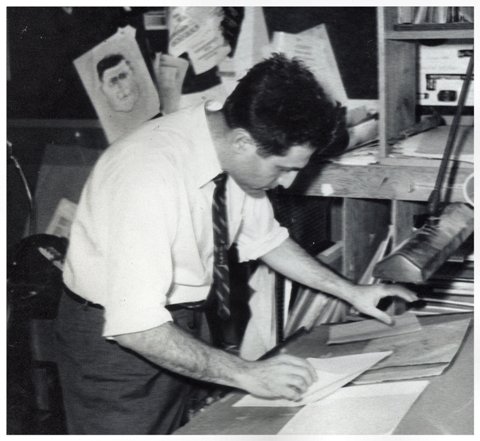
FOREWORD

This
book is a presentation of the graphic work of Saul Sophrin; an
oeuvre spanning over sixty years and including linoleum prints,
woodcuts, and serigraphs. The artist’s work is firmly grounded
in 20th century printmaking. In
Sophrin’s prints, there is a confluence of influences; he was
drawn to the bold, innovative use of woodcut and linoleum
printmaking of the German Expressionists and the powerful
woodcut books and images of Flemish printmaker Franz Masereel.
His sensibilities as an American artist drew strongly from the
humanistic impulses of the Ashcan School and what followed. In
his images one can find echoes of John Sloan, Edward Hopper,
Martin Lewis and others. Sophrin emerged from his studies at
Cooper Union in the late ‘40’s, entering the art world on the
heels of the great surge of socially conscious art making that
was the WPA.
While
pursuing a full-time career in graphic design in New York City,
he simultaneously worked in his own Brooklyn studio; painting,
drawing and putting out a stream of prints which has continued
for over six decades. During his years in New York, he continued
painting studies under Isaac Soyer and others.
In his linocuts, he began exploring in
black and white, the bones of his city; it’s buildings, streets,
conveyances, parks, and those who peopled them – the masses of
individual people who called the city their home.
The
earliest linocuts of subway and city life, done in the late
1940’s, employ a stunning black and white simplicity. As the printmaking
continued, Sophrin developed a sophisticated rhythm of lines,
marks and patterns, carving an increased form and depth into the
rich black which he found so visually exciting, and deepening
the works’ narrative qualities as well. In the 1970’s and into
the ‘90’s, Sophrin created many color prints; usually using
multiple blocks to obtain the different colors, but sometimes
employing the one-block reductive method used most famously by
Picasso. He explored inventive inking and hand-coloring
processes. Sophrin continued to experiment with new uses of
technique and style, expressing through the printmaking process,
a changing, developing vision of the world he saw around him.
His use
of serigraphy (silk-screen) started early, and re-emerged in the
80’s, when, with his wife Helen as studio assistant, he printed
a series of small-scale serigraphed cards for sale and
distribution. Sophrin produced and distributed remarkably large
editions of prints annually.
He also produced four subscription limited-edition series with
prose text entitled Notes
in Black and White.
Interwoven into Sophrin’s lifetime of observation and commentary
on urban American life, is an equally in-depth exploration of
musical themes, interiors, still-lifes, and portraits, most
notably of his favorite model, his wife Helen. What he presents
is the harmonious, whole-world view of one artist, through the
lens of the print.
- Diane
Sophrin
2011